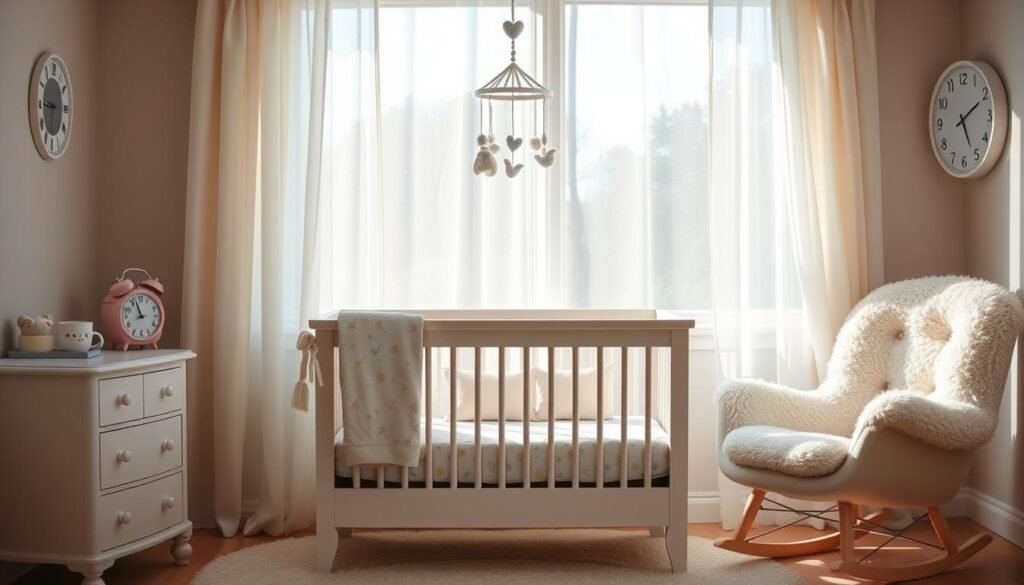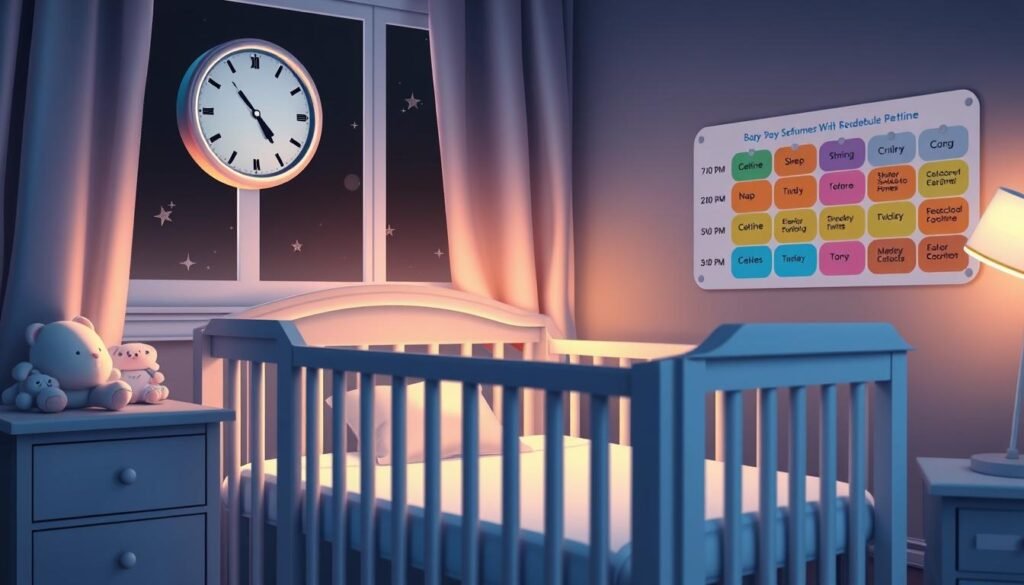When your baby is 8 months old, it’s key to set a regular sleep routine. At this stage, they need about 14 hours of sleep each day. This includes 11-12 hours at night and 2-3 hours in naps during the day.
Most 8-month-olds need 2.25-3.5 hours of time awake between sleep periods. The longest wake time is usually before bedtime.
Remember, every baby is different, and their sleep needs can change. Watch your child’s mood and energy to adjust their sleep schedule. Premature babies should use their adjusted age for sleep development.
With the right mix of night and day sleep, your 8-month-old can do well. Understanding their sleep patterns and making adjustments helps them get the rest they need to grow.
Understanding Sleep Patterns at Eight Months
When your baby is 8 months old, their sleep patterns start to change. Knowing these changes helps you create a routine that meets their needs. This ensures your baby gets enough rest.
Normal Sleep Duration Ranges
At 8 months, babies usually sleep 10-12 hours at night. They also take two naps, adding up to 2.5-3.5 hours of daytime sleep. Overall, an 8-month-old sleeps 12-16 hours in a 24-hour period.
Signs of Healthy Sleep Development
Consistent nap times and longer nighttime sleep show healthy sleep development. Your 8-month-old’s sleep schedule should become more predictable. This makes it easier to establish a reliable routine.
Impact of Development on Sleep
Exciting milestones like crawling or pulling up can affect your 8-month-old’s sleep. These changes are normal and usually settle as your baby gets used to their new skills.
“Understanding your 8-month-old’s unique sleep needs is key to supporting their healthy development and your family’s well-being.”
Recommended Total Sleep Hours for 8-Month-Olds
The American Academy of Pediatrics (AAP) has guidelines for your 8-month-old’s sleep. They say your baby should sleep 12 to 16 hours each day. This includes 11-12 hours at night and 2-3 hours during the day.
At this age, most babies still need two naps a day. Each nap should last between 30 minutes and 2 hours. The AAP advises against any nap lasting more than 2 hours. Also, the last nap should end by 4:30-5:00 pm to ensure bedtime is before 8 p.m.
Remember, every baby is different. You should watch your baby’s cues and adjust their sleep schedule as needed. Some might need more or less sleep than others. The goal is to find the right balance for your baby’s health and happiness.
| Sleep Metric | Recommended Amount for 8-Month-Olds |
|---|---|
| Total Daily Sleep | 12-16 hours |
| Nighttime Sleep | 10-12 hours |
| Daytime Naps | 2-3 hours (2 naps, 30 minutes to 2 hours each) |
| Last Nap Ending Time | 4:30-5:00 pm |
| Bedtime | 7:00-8:00 pm |
By following the AAP’s sleep guidelines, you can help your 8-month-old get the rest they need. This is crucial for their growth and development.
8 Month Old Sleep Schedule and Wake Windows
At 8 months, your baby’s sleep habits start to change. It’s important to understand these changes to create a caring routine for them. Let’s explore the sleep schedules and wake windows for 8-month-olds.
Morning Wake Window Guidelines
The morning wake window for an 8-month-old is usually 2.5 to 3.5 hours. This means they might need their first nap around 9:45 AM, after waking at 7:00 AM. Watch for signs like yawning or rubbing their eyes to know when it’s nap time.
Afternoon Wake Period Management
In the afternoon, the wake window can be 3-3.5 hours. This allows for a longer second nap, often at 2:30 PM. Keeping a consistent nap routine helps your baby smoothly move into the evening.
Evening Wake Time Adjustments
As evening comes, the wake window shortens to 2.5-3 hours. This usually means bedtime is between 7:00 PM and 8:00 PM. A soothing bedtime routine helps your baby relax and sleep well.
Every baby is different, and their sleep can vary. Pay attention to your baby’s signs and adjust their wake windows to ensure they get enough rest.

“Establishing a consistent sleep schedule and wake window routine can make a world of difference in your 8-month-old’s overall well-being and development.”
Managing the Transition from Three to Two Naps
When your baby is 8 months old, they might start dropping their third nap. This change can be tough, but with the right steps, you can help your baby adjust easily.
Look for signs like refusing the third nap or taking too long to fall asleep. You might see days with two naps and days with three. To avoid tiredness, adjust bedtime a bit earlier during this time.
Expect some sleep issues as your baby gets used to the new schedule. This is normal. With patience and consistency, your baby will find their new sleep pattern. Remember, every baby is different, and it can take 2 to 4 weeks to adjust.
- Most babies drop the third nap by 8 – 9 months old.
- Wake windows for three naps are 2 – 2.75 hours, and for two naps, they’re 3 – 3.5 hours.
- The third nap is usually 30 – 45 minutes long.
- Babies switching to two naps might resist naps, skip them, or wake up early.
Adjusting your baby’s schedule and bedtime is key during this transition. With patience and some tweaks, your baby will do great on a two-nap schedule.
“The adjustment period from a three-nap to a two-nap schedule can take a few weeks.”
Every baby is unique, and adjusting to two naps can vary. If you need help, talk to a certified sleep consultant. They can offer personalized advice to help your baby with infant nap routines and baby sleep patterns.
Creating an Optimal Daytime Nap Routine
Creating a consistent nap routine is key for your baby’s sleep health. As your 8-month-old moves from three naps to two, knowing the best practices is important. This helps manage their daytime sleep needs.
Morning Nap Best Practices
The morning nap starts 2.5-3 hours after waking. It should last 1-1.5 hours. A calming pre-nap routine, like reading or a lullaby, helps your baby sleep well.
Afternoon Nap Structure
The afternoon nap starts 3 hours after the morning nap. It also lasts 1-1.5 hours. This nap is vital for your baby’s brain growth and energy.
Managing Nap Transitions
By 8 months, your baby might need to switch to two naps. Signs like not wanting the third nap or shorter sleeps mean it’s time to change. Slowly increase wake times and adjust nap lengths to help your baby sleep right.
Consistency is crucial for bedtime and nap routines. A predictable sleep environment and schedule support your 8-month-old’s sleep development. This sets the stage for restful nights for life.

Establishing a Consistent Bedtime Routine
As your 8-month-old grows, a regular bedtime routine is key. It tells your baby it’s time to relax and sleep. A calm routine helps your baby smoothly move from play to sleep.
Begin your bedtime routine 30-45 minutes before you want your baby to sleep. This is usually between 7:00-8:00 PM. It matches your baby’s natural sleep cycle. Activities like a warm bath, reading, singing, or massage are great.
Make sure the room is dim and quiet. This helps your baby know it’s time to sleep. Stick to the same routine every night. This lets your baby know what to expect.
- Establish a consistent 30-45 minute bedtime routine to signal sleep time
- Include calming activities like bath, story, lullaby, or gentle massage
- Maintain a dim, quiet environment during the routine
- Aim for a 7:00-8:00 PM bedtime to align with your baby’s natural sleep cycle
A regular bedtime routine helps your 8-month-old sleep well. It supports their health and growth.

“Consistent bedtime routines lead to fewer night wakings and more consistent sleep patterns.”
Common Sleep Challenges at Eight Months
When your baby hits 8 months, you might face some sleep issues. The 8-month sleep regression, also known as the 9-month sleep regression, is common. It can last from 2 to 6 weeks. It’s caused by growing out of the 3-nap routine, feeling anxious, moving more, and even teething.
Sleep Regression Signs
Look out for these signs in your baby during the 8-month sleep regression:
- Increased night wakings
- Shorter naps
- Difficulty falling asleep
Developmental Impact on Sleep
As your baby hits new milestones, like crawling or pulling up, their sleep might change. This is normal. Their growing brains and bodies adjust to these big changes.
Managing Sleep Disruptions
To help your baby through the 8-month sleep regression, keep routines consistent. Avoid new sleep habits during this tough time. If teething is causing discomfort, talk to your pediatrician about safe pain relief.
Remember, sleep regressions are a normal part of your baby’s growth. With patience and consistency, you can help them through this. By understanding the signs and managing disruptions, you support their healthy sleep during this exciting time.
Setting Up the Perfect Sleep Environment
As your little one hits 8 months, making their sleep area cozy is key. Create a dark, comfy spot that meets their needs. This will help them sleep better.
Keep the room warm, between 68-72°F (19-21°C). This is perfect for your baby’s comfort. Use a fan and white noise to keep things calm. White noise can lower SIDS risk by up to 72%.
Blackout curtains or blinds are essential, especially in summer or for early risers. Dark rooms tell your baby it’s time to sleep. Melatonin, the sleep hormone, is made when it’s dark.
- Make sure the crib is low if your baby is trying to climb, to avoid falls.
- Use a sleep sack for warmth and to stop them from climbing out.
- Keep the crib area free from toys or things that might wake your baby.
By making a sleep-friendly space, you’re helping your 8-month-old get a good night’s sleep. A well-rested baby is happy and healthy!
“A consistent bedtime routine and a sleep-friendly environment are crucial for your baby’s sleep at this age.”
| Sleep Environment Factors | Recommended Ranges |
|---|---|
| Room Temperature | 68-72°F (19-21°C) |
| White Noise Volume | 50-60 dB |
| Room Darkness | 8-10 on a scale of brightness |
Signs of Sleep Readiness in Your Baby
It’s important to know when your baby is ready for sleep. Their sleep patterns can change a lot. But, there are signs that show they need a nap or bedtime.
Eye-rubbing or yawning are common signs of sleepiness. Your baby might also become less active and fuss or cry more. These signs mean they’re tired and need to settle down.
Putting your baby down when they’re drowsy but awake is key. This helps them learn to fall asleep on their own. It makes bedtime easier and more peaceful.
It’s crucial to know the difference between sleepiness and other needs like hunger or discomfort. Meeting your baby’s needs helps them get the rest they need to grow. Learning to read their sleep signals helps avoid sleep deprivation.
“Paying attention to your baby’s sleep cues and responding accordingly is one of the best things you can do to support their healthy development.” – Dr. Jane Smith, Pediatric Sleep Specialist
Adjusting Schedule for Different Sleep Needs
Every baby is different, and their sleep needs can change. The typical 8-month-old sleep schedule is a good start, but it’s not set in stone. You need to listen to your baby and adjust as needed. Some might need longer or shorter wake times, or different nap lengths.
Switching from co-sleeping to a separate bed can be tricky. Start by introducing the new bed slowly and keep a bedtime routine the same. This helps your baby learn to sleep alone and sleep better at night.
If you’re worried about your baby’s sleep or growth, talk to your pediatrician. They can give advice tailored to your baby’s needs. By paying attention to your baby’s unique sleep needs, you can find a sleep schedule that works for your family.


